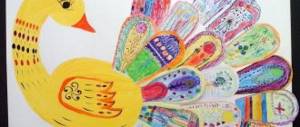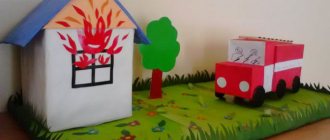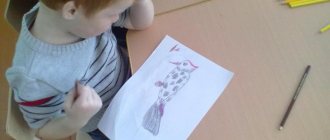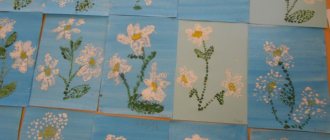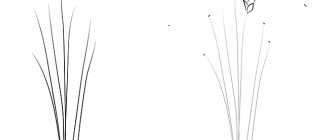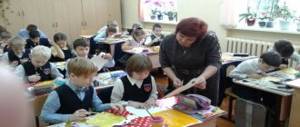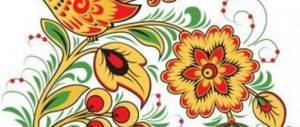Preparation
The result of achieving the goals and objectives depends on how thoroughly the teacher prepares for the lesson - this is no secret. And taking into account all the subtleties of the preparatory process plays an important role in this process.
Materials
In the preparatory group, children are already familiar with the main types of drawing materials. That is, they can use
- pencils;
- gouache;
- watercolor;
- wax crayons;
- markers.
This is interesting. Many methodologists categorically deny the possibility of using felt-tip pens in drawing classes in kindergarten, since children cannot use them to convey shades and elementary shadows in an image.
The basis
As a basis for drawing you can use:
- paper of different thicknesses (colored or printer paper);
- cardboard (thick and thin).
The only condition is that the drawing format should not be larger than A4 if we are talking about individual work. For group assignments, you can use sheets of A3 and even A1 format.
This is interesting. Images on whatman paper are allowed if the teacher takes an active part in creating the overall composition of the work.
Techniques and techniques in the preparatory group
It is assumed that in the preparatory group children already know a number of non-traditional drawing techniques (for example, blotography, when an outline is applied to random spots of paint, or palm painting, when various images are created based on the outline of the palms). However, classical techniques still remain a priority. Among them
- coloring picture templates;
- completing the composition on a ready-made background (for example, a forest background is complemented by a drawing of a hedgehog, squirrel, mushrooms, berries, etc.);
- sketching (this technique is actively mastered in the senior group and practiced in the preparatory group);
- tracing and coloring stencils (in the group the figures depicted are becoming more complex, animals appear with traced contours of fur, small objects in the composition, etc.);
- drawing from life (natural materials are used as nature - branches, stumps, acorns, chestnuts, etc.).
To depict mushrooms and berries, it will be important to use additional drawing, sketching and drawing from life.
Drawing techniques are determined by the fact that children already have clear ideas about the point-boundaries of the image, determined by the idea of the drawing. Available for children 6–7 years old
- any form of painting (small, large details, as well as elementary shadows);
- drawing thin and wide lines in any direction;
- vertical position of the brush when drawing thin lines and inclined position of the brush for wide lines (when using paints);
- dipping, when a brush dipped in paint is applied to the paper with all its bristles to make a print;
- mixing a watercolor palette to obtain different shades;
- techniques for painting in different positions of the pencil in relation to the sheet.
In a lesson on mushrooms and berries, you can combine all these techniques, depending on what materials will be used.
Photo gallery of drawings made using non-traditional techniques
Using semolina, painted in different colors using watercolor or gouache, allows you to quickly fill the image with color. Drawing with cotton swabs is one of the types of blotography, when an object takes shape from a spot of paint. To create this drawing, the technique of imprinting paint from fingers was used.
How to personalize work?
The implementation of an individual approach is one of the main goals of the educational process in kindergarten. This is easier to do in drawing classes than in others, since the final product is a priori unique. And yet, the teacher can already achieve the goal at the stage of setting the task. To do this, an adult can give the following drawing options:
- present the composition at different times of the day (day, night, morning) or different times of the year, which implies the use of different colors;
- depict a picture from life in different approximations (for example, from close range if the baby has vision problems);
- add one element to a given composition at your discretion and prove the validity of this detail.
This is interesting. To individualize the drawing, you can invite children to add elements of other types of visual activities, for example, appliqué made from natural materials, fabric, or three-dimensional plasticine parts.
Composition options
Drawing, as already mentioned, can be done individually and collectively. In the latter case, it is better if these are elements (for example, pine, squirrel, mushrooms, etc.) made on separate sheets and then placed against a general background. Alternatively, children can color individual blocks of the overall composition. As for the thematic variety of using images of mushrooms and berries as a task, this is traditionally an “autumn-winter” thematic block, when kids study natural phenomena, the life of animals associated with the changes of the seasons. You can suggest the following ideas for wording the topic:
- “Supplies for a hedgehog”;
- "Rowan Branch";
- "Mushroom Glade";
- "Amanita";
- “Bullfinches on a rowan branch”;
- “Who hid there under the tree?”;
- “Gifts for a squirrel”, etc.
Preparation for a drawing lesson on the topic “Mushrooms and Berries” in the preparatory group of a kindergarten
Drawing is one of the main forms of creative activity of a child. Classes held in kindergarten serve the harmonious and emotionally positive development of the preschooler, prepare for primary school and develop personal qualities. Working with a brush, pencils and felt-tip pens develops fine motor skills and prepares the hand for mastering an important skill for future life - writing. In drawing classes, a child gains knowledge about colors and shades, learns to see beauty in various color combinations. Spatial thinking develops, the concepts of composition and perspective are reinforced. Figurative memory and thought processes are activated.
Objectives of teaching drawing in the preparatory group
- Development of aesthetic feelings: color and compositional perception of objects, sense of form, rhythm, proportion. By directing children to a specific visual perception of objects, the teacher must teach them to see the beauty of objects and the unique properties of objects.
- Development of spatial thinking, consolidation of compositional abilities. Older preschoolers should be able to create a three-plane composition.
- Learning to highlight the main or most significant properties of an object using color, image size, and location in the foreground of the picture.
- Development of drawing skills based on ideas (on themes of the surrounding reality, based on fairy tales).
- Encouragement for independent creative activity, activation of the child’s imagination.
Pupils of the preparatory group are familiar with the basic types of drawing
and use various techniques and techniques to realize the creative concept:
- Subject drawing.
Children learn to realistically convey in a drawing the characteristic shape of an object or its parts, respecting proportions, color, volume, and movement. Children aged 6–7 years are actively developing analytical thinking, they learn to identify common features of objects and the features by which they differ from one another. Drawing is not carried out in classes in the senior and preparatory groups. It is possible to examine samples of finished works on a given topic, discuss execution techniques, and drawing techniques. There is no direct demonstration of actions. It is recommended that, while studying technology maps and visual instructions, together with students, build an oral plan for performing actions. Great importance is given to drawing objects from life: children learn to convey the characteristic features of structure and form using specific examples. In the preparatory group, children draw objects based on their imagination, using images from their visual memory and following their imagination. - Subject drawing.
Preschoolers learn to convey their impressions and sensations by drawing objects and displaying their understanding of the connection between them and interaction. In the preparatory group, children are given the opportunity to independently come up with a plot (small scene) on the topic of the lesson. The compositional abilities of young artists develop: they arrange the drawing over the entire area of the sheet, learn to determine the position of objects - foreground and background. In the graduating group of kindergarten, children master the ability to convey the characteristic movements of objects, overcome the conventionality and static nature of the image. - Decorative drawing.
Learning to decorate a paper blank or papier-mâché figurine fulfills the requirement of developing aesthetic taste in art classes. Preschoolers get acquainted with the folk crafts of our country, learn to see beauty in the products of craftsmen from the people. The children use the acquired knowledge about the features of Gzhel, Khokhloma, and Gorodets paintings in creating their own patterns based on folk painting.
For the topic “Mushrooms and Berries” in the preparatory group, the most relevant is subject drawing from life or from an idea: “Spruce branches”, “Bunch of rowan berries”, “Fly agaric”, “Mushrooms in the forest”, “Family of honey mushrooms”, etc. Guys They practice the skills of creating a composition, arranging objects on a sheet of paper, learning to fill the entire sheet with a drawing, and creating an unusual background. Drawing from life will be the main method in school. In the preparatory group, students are not tasked with depicting the volume of an object or creating light and shade. The goal in teaching children 6–7 years old is to learn to identify the features of an object in front of them and display them in a drawing: the shape of the object, its parts, the relationship of parts with the main figure. Analyzing an object and conveying its details is successfully carried out by children 6–7 years old when the object is close to each other. Classes that have a game element at their core are effective. For example, in front of each student, a sprig of rowan is placed on the table, which, according to the assignment, must be drawn from life. Each person studies only his own branch, identifies and depicts its features (one or two clusters of berries, a forked branch, the number of leaves, fresh or withered foliage). At the end of the lesson, the teacher collects the twigs and places them on the common table, inviting the children to find from the drawings who drew which branch.
Work on this topic is often carried out using the method of plot drawing: “Bullfinches pecking a rowan tree”, “A squirrel jumped onto a branch”, “Mushroom hedgehog”, “Who hid under the fungus”, etc. Pupils of the preparatory group learn to depict the characteristic movements of birds and animals, think through small story scenes. In decorative painting, mushrooms and berries are also used to create floral patterns on the workpiece.
As a basis for the drawings, sets of white and colored paper, special for watercolor and gouache, and Whatman paper are used (usually for creating collective works or implementing creative projects). Tinted paper is rarely used for work, mainly to create a decorative pattern based on folk painting. In subject and subject drawing classes, children learn to create a background on their own (plain or with smooth transitions).
Drawing techniques and techniques
Let's consider in the form of a table what techniques senior schoolchildren should master as part of learning drawing in the preparatory group:
| How a drawing is created | Techniques and drawing techniques |
| Pencils, felt-tip pens | Creating a sketch: using a light line, without pressing on a sheet of paper, the contours of the object are transferred. Pencil pressure adjustment. Creating hatching with varying degrees of pressure and scope without going beyond the contours of the image. Using colored markers to draw outlines and details of objects. |
| Paints: watercolor, gouache | Mixing paints on a palette. Blurring paint on a large surface. Applying strokes and strokes to the shape of an object. Baking (overlaying vertical strokes). Drawing with the tip of a brush (overlaying lines or pokes). Drawing on a wet background. |
| Dry pastel | Mastering graphic drawing techniques (pastels of one color). Creating the main tone by shading using a hard brush. Drawing smooth lines. Developing accuracy when drawing with pastels: holding a sheet of paper while drawing, shaking off dust on a napkin. |
On the topic “Mushrooms and Berries,” classes are held on non-traditional drawing techniques: wax crayons with sketching with watercolor paint, cotton swabs, chalk on sandpaper, scratch paper techniques, monotype, etc.
Examples of drawings of mushrooms, branches and berries made using non-traditional techniques
Drawing with prints Scratchboard Blotography Finger painting Monotype Blotography Finger painting Drawing with wax and watercolor Dot painting Drawing with crayons on sandpaper “Poke” method
In the process of educational activities, a person-oriented approach should be implemented. When preparing to conduct drawing classes in a preparatory group, the teacher must take into account the individual characteristics of each child. This is the degree of proficiency in specific drawing techniques, the ability to work in mixed media, the degree of involvement in collective activities. All students must achieve the goal set at the beginning of the lesson. For those who have difficulties in the process of creating a drawing, the teacher uses a form of individual demonstration. Successful students are additionally given tasks to decorate a finished drawing or design a general composition in a subgroup (creating a panel on a sheet of Whatman paper).
The personal approach is implemented through the freedom of choice by students of drawing materials. Children should be given access to sets of paper, pencils and markers, paints and crayons. Older preschoolers, based on an assessment of their capabilities, have the right to independently choose a drawing technique to complete the task.
The main thing in implementing a student-centered learning concept is allowing freedom of design. The child is given a topic that involves activating the imagination. Drawing with a plot is especially conducive to imagination: the child comes up with images for the drawing, a situation, the relationship of objects.
Options for individual and collective compositions on the theme “Berries and Mushrooms”
| Lesson topic | Class organization form | Training and development tasks | Techniques and drawing techniques |
| "Rowan Branch" | Individual. | Formation of the ability to draw from life, analyze an object and identify its characteristic features. Development of compositional skills. | Drawing with watercolors. Honing the techniques of painting with a brush (all lint/bristles and tip). |
| "Mushroom hedgehog" | Individual. | Formation of artistic thinking, development of imagination. | Creating a preliminary sketch with a simple pencil. Creating a background. Elaboration of details (shading, lines, strokes, pokes). |
| "Mushroom Glade" | Collective. | Development of compositional skills. Formation of the concept of perspective (foreground and background). Consolidating the skill of object drawing with the transfer of characteristic features of objects. | Drawing on a common sheet of Whatman paper in subgroups. Dipping technique with a brush (mushrooms). Method of drawing with crumpled paper (grass). |
| Individual. | Consolidating the skill of object drawing. Development of visual perception. | As a rule, in the preparatory group a lesson on this topic is conducted using the finger painting technique: Drawing vertical lines - long and short. Drawing dots. | |
| "Mushrooms in the Forest" | Collective. | Activation of memory and attention processes. Consolidating the skill of object drawing. | Drawing in subgroups. Drawing with pencils: Hatching within the contours of a sketch with varying degrees of pressure. Creating outlines with colored felt-tip pens. |
| "Who hid under the fungus" | Individual. | Activation of memory and imagination. | Drawing in mixed media - watercolor and gouache. Preparation of the background. Drawing on a wet background. Drawing with strokes of different directions. Working on small details with a thin brush. |
| "Bullfinches on a Rowan Branch" | Individual. | Development of plot drawing skills. Activation of figurative memory, development of the ability to analyze and predict. | Drawing with gouache: Preparing the background. Drawing with strokes. Drawing details with a thin brush. |
| "Fairy Mushroom" | Individual. | Development of drawing skills based on ideas. Activating the imagination. | Drawing with colored pencils: Creating a sketch. Thinking through the background. Hatching with varying degrees of pressure. Drawing details (possibly with a felt-tip pen). |
Motivation
The involvement of children in work depends on how much the teacher manages to interest them in the topic. To do this, you can use a whole arsenal of techniques, combining them depending on the topic and time frame of this stage of the lesson.
Songs
Musical accompaniment of classes allows not only to create a favorable atmosphere in the children's group, but also to present the necessary information in an unobtrusive form, for example, about what edible mushrooms look like. Moreover, you can choose videos so that kids not only listen and sing along, but also perform certain rhythmic movements. In this case, motivation can be combined with physical education.
Video: Example of a video clip for children “Mushrooms and Berries”
Poems
Rhymed lines easily and accurately fit into children’s memory, which is why in preschool education, memorizing poems by heart is almost the main method of consolidating acquired knowledge. For a drawing lesson, poems can be selected separately by type of mushrooms and berries, or in general about the gifts of autumn, for example.
- They walked along the path - they found Borovik. The boletus hid its head in the moss. We could pass it, it’s good that we walked quietly.
- Golden foxes - Curious sisters. They wear red berets, they bring autumn to the forest in summer.
- I walk through the forest, I look at the berries: There is a raspberry on the bush, There is a rowan on the tree, There is a strawberry in the grass, There is a blueberry under the mountain, Klyukovka is on a hummock... - The box is empty!
- - Autumn! Tell me quickly, have you saved anything for the animals? - I will give the bear and wood grouse a lot of berries. And cloudberries, and raspberries, and ruddy rowan. - And for the forest squirrel I have a different surprise: I will give the red-haired baby Acorns, mushrooms and pine cones.
Puzzles
This is a quick and very productive way to get children into the mood for work, since solving riddles does not require much time, and kids listen with pleasure and try to give an answer as quickly as possible.
- This fungus is the son of a birch tree. Whoever finds it, everyone puts it in a basket (Boletus).
- The mushroom is red - dangerous to health (Amanita).
- Yellow-red foxes - they call us sisters (Little Chanterelles).
- Near the stumps and on the lawn We always walk in a flock. Very friendly guys, They call us... (honey mushrooms).
Fairy tales
One of the win-win options to get kids to work is fairy tales. As motivation for a drawing lesson on the topic of berries and mushrooms, you can suggest not just listening to ready-made stories, but coming up with your own (from 2-4 sentences) on a given topic. For example,
- Once upon a time there lived a friendly family of cheerful mushrooms. One day a misfortune happened: the little brother got sick, so much so that he turned green all over...
- A daughter was born to the mushroom king Boletus, and he threw a feast on this occasion. He invited distinguished guests: Borovik and Borovikha, Gruzdya and Volnushka and other mushroom inhabitants...
- Chanterelles grew up in a clearing, bright and orange, and the evil witch Toadstool White lived nearby...
Conversation and visibility
It’s hard to imagine drawing without pictures. Children should see different options for interpreting the image that they have to reproduce. That is, if we are talking about berries, the images should be made from different angles, always with enlargement (for example, individual rowan berries, and not just bunches). And, of course, looking at the pictures should take place during a conversation on the topic.
- How often do you go to the forest?
- What grows in the forest?
- Why are mushrooms and wild berries needed?
- What can you do with mushrooms or berries at home? etc.
Scheme for drawing up lesson notes
A detailed plan for working with children in a specific period of time is that part of the methodological work that determines the professionalism of the teacher. And you should start preparing your lesson by formulating your goals:
- teach children to depict mushrooms and berries on paper using different techniques;
- consolidate children’s knowledge about the structure of forest flora, shapes and colors of plants;
- train the skill of depicting several objects on one line;
- expand children’s understanding of natural phenomena;
- develop creative abilities;
- cultivate respect for the environment;
- instill a positive attitude towards creativity and communication with each other.
The tasks may be the following:
- consolidate knowledge about edible/poisonous mushrooms/berries;
- develop memory, cognitive sphere;
- automate the ability to distinguish mushrooms/berries from pictures or riddles/songs/poems;
- cultivate patience in work.
It is very important to observe the timing of each stage of work.
- Introductory part - 5 minutes (repetition of what we did last time, motivational techniques).
- The main stage of the work is 20 minutes (formulating the task, performing the work with the obligatory inclusion of physical education and finger gymnastics in the timing).
- The final stage is 5 minutes (drawing up a group composition or designing individual works on one stand, words of encouragement from the teacher and the child’s reflection, for example, in the form of questions - Did you like the lesson? What did you like? or What did you not like? Did you manage to draw everything you planned? How? will you rate your picture? Which picture, in your opinion, is the most beautiful? Why? etc.).
Example of lesson notes
Vasilyeva Svetlana “There are a lot of mushrooms in the autumn forest.” Open drawing lesson in the senior group (teaching the “dipping” method)” (fragment)
| Educator: Here is an autumn forest (showing a drawing). Here I have a picture of grass (I show it in the picture). I'll take a brush and dip it in white paint and immediately paint a lot of mushroom stems. The legs turned out to be straight (I show and talk about image techniques by applying the entire bristle of the brush to the paper). And now I’ll rinse the brush well, (I show how) I’ll dip it in brown paint and paint it on the legs of the hat. The legs stand, and the caps lie on them (showing a horizontal stroke). Educator: Guys, let's get to work. And the squirrel will help us. Children: Draw (the teacher helps). Squirrel: praises the mushrooms in the drawings, thanks the guys for their help. The squirrel calls several children to help them find strong porcini mushrooms. Squirrel, together with the children, places the drawings on the stand (discussing the drawings). Reflection: Guys, how did we help the squirrel? What did you draw? Where did you go? What did you like most?> |
Preparation for class
The ability to plan is one of the important qualities of a teacher. It is lesson planning, careful preparation of all necessary materials, setting goals and objectives that primarily influence how successfully students will cope with the topic.
Materials
Drawing promotes the development of fine motor skills in a preschooler and prepares his hand for mastering the most important skill - writing. To draw mushrooms and berries using traditional techniques, you can use the following materials:
- gouache and watercolor paints;
- markers;
- gel pens for tracing contours and drawing details;
- colored and black lead pencils;
- wax crayons.
Wax crayons can be used to do all the work, or part of it in combination with paints
For the basis of the drawing, you should use paper of different formats (Whatman paper and A3 for collective works, A4 for individual works). You can use cardboard depending on the objectives of the lesson.
Additionally, during classes you should use:
- palettes for mixing colors;
- oilcloth for the table;
- brushes;
- erasers;
- sippy jars;
The workspace can be organized so that 4-6 children sit facing each other, and in the center of the table there are jars of paints, sippy cups, sets of pencils and other materials
Drawing techniques and techniques
For older preschoolers, traditional drawing techniques are a priority:
- filling with color and drawing details inside the template outline;
- drawing objects and characters on a pre-prepared background;
- copying from pictures;
- drawing from life, which is especially good to practice on natural materials (twigs, leaves, mushrooms and berries);
- stencil drawing.
At the same time, it is assumed that by the age of 6–7 years, pupils already know some unconventional techniques, such as drawing the details of an object with a felt-tip pen on top of a watercolor blot.
Drawing can also be combined with sculpting and appliqué. For example, a mushroom made from salt dough can be painted in different colors. A flat design can be supplemented with applique details made of colored paper, plasticine, soldering, dry leaves, etc.
This work combines gouache for the background and main objects, a felt-tip pen for drawing the face and paws of a hedgehog, gel pens for the veins on the stems of mushrooms and blades of grass; paper clouds attached with glue stick
Drawing with felt-tip pens takes less time than with paints, since it does not require additional preparation of the workplace, mixing colors in the palette, and does not require you to wait until part of the drawing dries. Therefore, in a drawing with felt-tip pens, children can place more decorative elements around mushrooms and berries: butterflies, sun and clouds, small blades of grass, etc.
Group work and individual approach
Preschoolers aged 6–7 years are already quite independent in order to think through the composition of their drawing, select colors, and determine the proportions of objects. As part of the theme of the lesson, smart and fast-working children should be given the opportunity to choose a plot or objects to draw, and let them think through the details themselves. At the same time, the teacher should think through in advance several alternative options, various plots from which the students will choose, so that this process does not take more than a couple of minutes during the lesson. If, according to the lesson plan, you need to have time to draw one object, for example, a hedgehog with a mushroom, then children can be allowed to draw something else (for example, berries) if they have time to complete the main task. For slow and lagging children, you can prepare stencils and templates.
Gallery: templates and diagrams on the theme “Mushrooms and berries”
Using this scheme, children will learn to draw rowan
Using this template, children can make a hedgehog as an applique from colored paper, and draw mushrooms on top with felt-tip pens or gouache
Invite the children to draw a fly agaric step by step
Using the template, children can draw not only a hedgehog, but also a squirrel with mushrooms. Using this template, it is easy to explain to children how to draw a fly agaric; you can also print it, cut it out of colored paper and attach it as an applique on a gouache or watercolor background
To awaken your child’s imagination, invite him to draw a mushroom house and come up with a story about its inhabitants
Using this template, children can learn to draw chanterelle mushrooms
According to this scheme, you can make bullfinches in advance during design classes, and then attach them using PVA glue or a glue stick to a drawing with bunches of rowan berries; this type of work can be done in groups
Teamwork is also good for developing children’s skills in assigning roles, planning, and the ability to negotiate. Drawing fairy-tale scenes with several characters, a forest clearing with mushrooms, berries and animals, or compositions where some of the objects are made using the applicative or origami technique are well suited for this.
Stages of working on a drawing
"Basket with mushrooms for a hedgehog"
To complete this drawing, you can use both watercolor and gouache. First, children make a pencil sketch of mushrooms, and then complete the drawing (without a pencil outline) of the basket.
Instructions:
- “We draw with a pencil the ovals of the caps and legs of the mushrooms.”
- “We paint them in yellow-beige-brown colors.”
- “We use beige paint to make an oval into which we write mushrooms.”
- “We finish drawing the basket, color it yellow.”
- “We let the background dry for 1-2 minutes and apply a pattern of cells with brown paint.”
- “We also use brown to imitate weaving on the handle of the basket.”
This is interesting. If there is no beige paint in the palette, then you can make it by mixing white with yellow, adding a little brown.
"Bunch of Rowan"
Instructions:
- “Dip the brush into brown paint and paint a twig.”
- “We apply thin short strokes like branches with green color.”
- “We draw berries on each branch, making dots with orange or red paint.”
- “Dip the brush into the green paint again and paint the branches for the leaves, making them thin but long.”
- “Now we apply the leaves by applying the bristles of the brush in one direction to the long green branches.”
"Amanita"
This drawing can be an illustration for a poem or fairy tale you have listened to, and since it is done with felt-tip pens, it takes a little less time to create. That is why such pictures can be supplemented with accompanying elements (in this case, butterflies, clouds, etc.).
Instructions:
- “We start by drawing the contours of the tree.”
- “We show the branches and draw marks on the birch trunk.”
- “Drawing the caps and legs of fly agaric mushrooms.”
- “We color them, not forgetting to leave white spots.” You can use not only felt-tip pens for coloring, but also pencils.
- “We draw butterflies. We draw an oval outline for the body, add wings in the form of the number 3, add a circle-head, and don’t forget about the antennae.”
- "Coloring butterflies."
- “We close the wavy lines into a shape similar to a circle - these are clouds.”
- “Coloring the clouds, finishing the sun.”
Ksenia Sabiryanova
Summary of a lesson on familiarization with the outside world in the senior group “Forest and garden berries”
Goal: to introduce children to the concept of
“
berry ”
, classify them into garden and forest ones
, and teach them to distinguish between them.
Tasks :
Continue to introduce the features of appearance and places where berries
.
Teach the ability to classify berries
according to the place of growth
(
garden ,
forest
)
.
Develop children's spoken language and encourage them to want to communicate.
Foster love and respect for nature.
